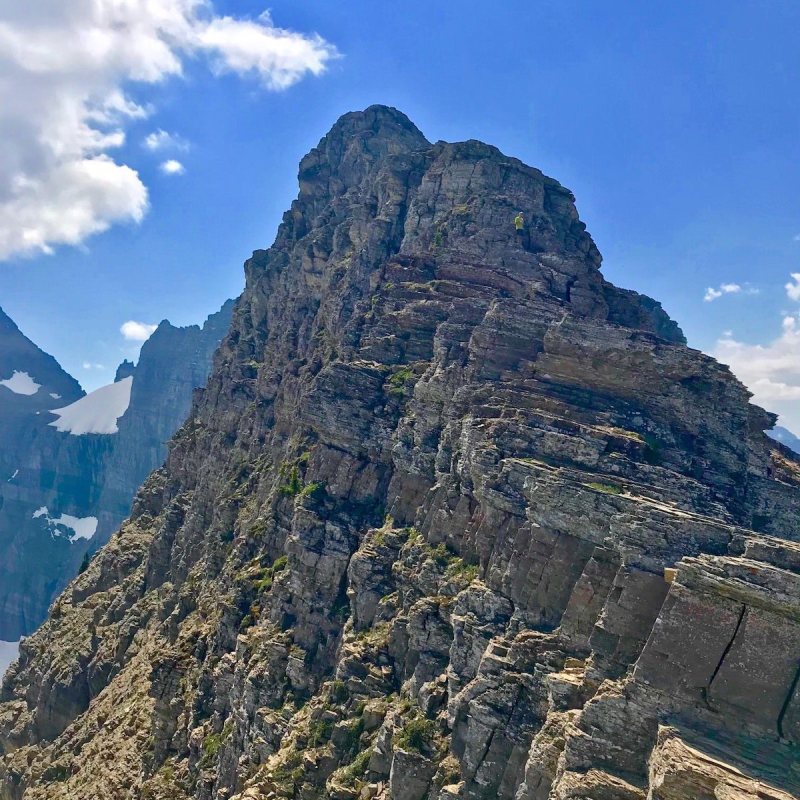
Michele Taylor Daniel
The Highline Trail is among the most popular trails in Glacier National Park, and that’s saying something, considering there are more than 730 miles of trails in Glacier. The Highline is really a one-way trip and includes a car shuttle at the end. The total mileage is just shy of 12, but it’s mostly downhill. Highlights include an extra mile to a glacier overlook, a junction to the east side of the park, and a 100+-year-old chalet built when the park was founded.
Videos by TravelAwaits
The way to do this hike is to park your car at the Loop, a big bend in the Going to the Sun Road, just about 25 miles from the west entrance to the park, and ride the free park shuttle to Logan Pass. That’s where the Highline starts. The benefits of this plan: You don’t have to search for hard-to-find parking at the pass and most of the walk is downhill. You’ll see some of the best vistas in the park are on your left as you head downhill, looking west to Mt. Oberlin, Mt. Cannon, and Heaven’s Peak, which dominates the view.
1. The Highline Is A Bit Challenging For Anyone With A Fear Of Heights
This is because of a short section along a 6- to 8-foot ledge. One hundred feet below a sheer drop is the Going to the Sun Road. Fortunately, the National Park Service installed a cable to hold on to for those of us who need reassurance we won’t tumble off the trail. This stretch of sketchy trail is less than a half-mile long. What can make it more exciting is when a goat is sharing the ledge with you. All you can do is yield the right of way. The rule in the park: Stay 50 yards away from animals. If your presence changes their behavior, you are too close. On nearby meadows, you’ll find bighorn sheep grazing. Again, stay 50 yards from them.
Editor’s Note: Consider our Tips For Safely Viewing Wildlife In National Parks well before making your way to Glacier.

Michele Taylor Daniel
2. The Highline Follows The Continental Divide
The Divide will be on your right as you head downhill. The divide is called the Garden Wall. Geologists call it an arete, or spine, carved on two sides by glaciers tens of thousands of years ago. Now, it’s a wall separating the east and west sides of the park.
As you continue on, you’ll see mountain wildflowers and in the spring, lots of small streams cross the trail. The trail follows the slope of the divide and about three and a half miles in, you get to the only real uphill you must take: into the saddle between Haystack Butte and the Garden Wall. It’s a busy spot with lots of folks using this as a place for a break. The uphill climb ends and you start on the downhill portion in earnest shortly after leaving the saddle. At about 7 miles, there’s an opportunity to check out the east side of Glacier. The side trail is on your right and heads up 900 feet in less than a half-mile. It is very strenuous and not for the faint of heart, but worth it: You climb to the top of the Continental Divide and peer over the Grinnell and Salamander Glaciers and Upper Grinnell Lake. You are one thousand feet above the glaciers. The tiny specks below are the hikers who are visiting the glacier from the Many Glacier area of the park. A word of caution: I have never been to the Garden Wall overlook when it wasn’t windy. Be prepared to cool off quickly and be ready to hold steady in the breeze.

Michele Taylor Daniel
3. There Are Numerous Side Trails; Choose Wisely
At about 7.5 miles, you reach the junctions of the Swiftcurrent trail and a trail to the Swiftcurrent Lookout. Going right takes you up and over the Continental Divide, into the Many Glacier Valley. That detour adds lots of miles to this hike and I don’t recommend the diversion unless you’ve arranged a car shuttle from the Many Glacier area of the park back to your own transportation.
Another caution: You may be tempted to leave your backpack at the beginning of the side trails and go uphill to the glacier overlook or to the Swiftcurrent Fire Lookout. This is not allowed since animals will take over your pack, leaving you, and the park, with a mess.

Michele Taylor Daniel
4. You’ll Get To Experience One Of The Backcountry Chalets
The end of the trail is to the left, about 5 miles away, but you get to stop and refresh at the Granite Park Chalet first. The chalet was built in 1914 by the Great Northern Railroad, which took on the job of building accommodations in Glacier. The railroad, now a part of the Burlington Northern Santa Fe Railway Company, did it to increase tourist traffic on its railroad. The company built nine chalets and two big hotels. The hotels are still operating, but there are only two backcountry chalets left: Granite Park and Sperry Chalet.
The chalet is pretty basic and the accommodations are bunks but you have to bring your own bedding. But even with the rustic conditions, the chalet is always sold out. Stop and enjoy your lunch here and enjoy the views. Heaven’s Peak is dominant. Even in late summer, it glistens with snow and you can see how the runoff makes the snow mirror-like. The chalet staff are friendly and you can purchase simple prepackaged stuff: chocolate bars, sports drink mix, and even water. I always prefer to buy my dessert here and sit on the chalet porch and enjoy the view. If you are interested in lodging, click here for both Granite Park and Sperry Chalet booking information.
5. You Need To Be Bear Aware
There’s an often hidden story about the Granite Park Chalet. It’s a tragedy that happened on August 12, 1967. A young female camper near the chalet was killed by a grizzly bear and a man was badly mauled. A few miles away, at another campground, a different young woman was killed by a grizzly. The events are called “The Night of the Grizzlies”, and books have been written about it. Both women were 19 years old and worked for the park concession operator at the time. It was determined that operators of the campground and the chalet left garbage out to attract the bears to entertain the tourists. Their legacy: dramatic changes in the way the park service manages wildlife, especially bears.
This entire hike is bear habitat and you must carry

Michele Taylor Daniel
6. Mind Your Knees As You Approach The Burn Area
The rest of this hike is all downhill to the loop and it can be hard on the knees, but there’s a payoff close to the trail’s end. You’ll walk out of the heavy forest eventually, into a burn area. The Trapper Creek fire of 2003 was started by lightning and burned nearly 20 thousand acres. In the years since, the forest is regenerating. The understory is full of new growth, surrounded by the gray snags of burned trees. There are wildflowers and new lodgepole pine trees reforesting the slopes.
7. Cool Off Before You Hop Back In The Car
Before you get to your car, and while you are hot and sweaty from the downhill stroll in the sunshine, take a few minutes to take off your boots and cool your toes in a small creek that crosses the trail. There’s a bridge, but on either side, there are rocks that make for a great place to cool down and talk about the Highline.
Your transportation is just a few minutes walk away — where you left it at the loop. It’s a great capper to the Highline.

Michele Taylor Daniel
Pro Tips
Be prepared to change your plans to walk the Highline at the last minute. I’ve been detoured more than once from this stroll. Sometimes, it’s the weather. Icy conditions really make the Highline sketchier than I’m willing to risk. The other detour is caused by bears. Park Service rangers will shut the trail down if there’s a bear frequenting the area. Several years ago, one bear closed the trail for days, as it was feeding. Always have a backup hike planned. Hidden Lake at Logan Pass is good but very popular. I suggest the hike to Oberlin Mountain. It’s also accessed from Logan, and any ranger will tell you how to find the trail, which is off the beaten track. Want more Glacier inspiration? Consider
